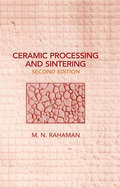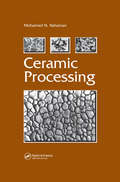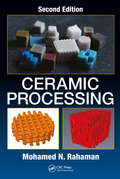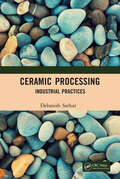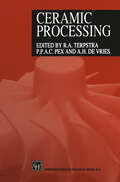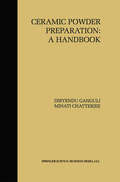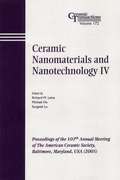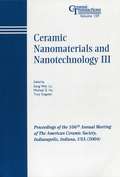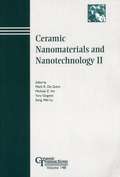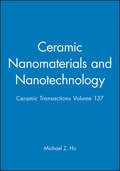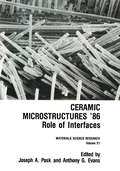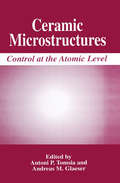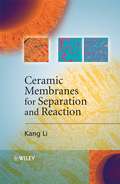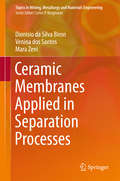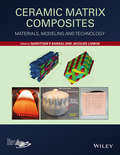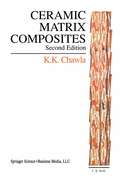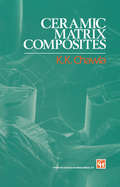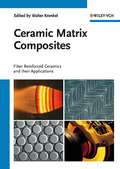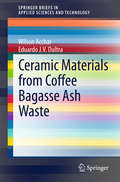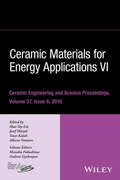- Table View
- List View
Ceramic Processing and Sintering (Materials Engineering #1)
by Mohamed N. RahamanAs the field's premiere source, this reference is extensively revised and expanded to collect hard-to-find applications, equations, derivations, and examples illustrating the latest developments in ceramic processing technology. This book is concerned primarily with the processing of polycrystalline ceramics and focuses on the widespread fabrication of ceramics by the firing of consolidated powders forms. A brief treatment of sol-gel processing is also included.Ceramic Processing and Sintering, Second Edition provides clear and intensive discussions on colloidal and sol-gel processing, sintering of ceramics, and kinetic processes in materials. From powder synthesis and consolidation to sintering and densification behavior, this latest edition emphasizes the impact of each processing procedure on ceramic properties. The second edition also contains new and extended discussions on colloid stability, polymer growth and gelation, additives in ceramic forming, diffusion and defect strucutre, normal and abnormal grain growth, microwave sintering, Rayleigh instability effects, and Ostwald ripening. Illustrating the interconnectedness between the various steps in the overall fabrication route, Ceramic Processing and Sintering, Second Edition approaches the fundamental issues of each process and show how they are applied to the practical fabrication of ceramics.
Ceramic Processing
by Mohamed N. RahamanMaterials scientists continue to develop stronger, more versatile ceramics for advanced technological applications, such as electronic components, fuel cells, engines, sensors, catalysts, superconductors, and space shuttles. From the start of the fabrication process to the final fabricated microstructure, Ceramic Processing covers all aspects of modern processing for polycrystalline ceramics. Stemming from chapters in the author's bestselling text, Ceramic Processing and Sintering, this book gathers additional information selected from many sources and review articles in a single, well-researched resource. The author outlines the most commonly employed ceramic fabrication processes by the consolidation and sintering of powders. A systematic approach highlights the importance of each step as well as the interconnection between the various steps in the overall fabrication route. The in-depth treatment of production methods includes powder, colloidal, and sol-gel processing as well as chemical synthesis of powders, forming, sintering, and microstructure control. The book covers powder preparation and characterization, organic additives in ceramic processing, mixing and packing of particles, drying, and debinding. It also describes recent technologies such as the synthesis of nanoscale powders and solid freeform fabrication. Ceramic Processing provides a thorough foundation and reference in the production of ceramic materials for advanced undergraduates and graduate students as well as professionals in corporate training or professional courses.
Ceramic Processing
by Mohamed N. RahamanMaterials scientists continue to develop stronger, more versatile ceramics for advanced technological applications, such as electronic components, fuel cells, engines, sensors, catalysts, superconductors, and space shuttles. From the start of the fabrication process to the final fabricated microstructure, Ceramic Processing covers all aspects of modern processing for polycrystalline ceramics. Stemming from chapters in the author's bestselling text, Ceramic Processing and Sintering, this book gathers additional information selected from many sources and review articles in a single, well-researched resource. The author outlines the most commonly employed ceramic fabrication processes by the consolidation and sintering of powders. A systematic approach highlights the importance of each step as well as the interconnection between the various steps in the overall fabrication route. The in-depth treatment of production methods includes powder, colloidal, and sol-gel processing as well as chemical synthesis of powders, forming, sintering, and microstructure control. The book covers powder preparation and characterization, organic additives in ceramic processing, mixing and packing of particles, drying, and debinding. It also describes recent technologies such as the synthesis of nanoscale powders and solid freeform fabrication. Ceramic Processing provides a thorough foundation and reference in the production of ceramic materials for advanced undergraduates and graduate students as well as professionals in corporate training or professional courses.
Ceramic Processing
by Mohamed N. RahamanMany of the properties critical to the engineering applications of ceramics are strongly dependent on their microstructure which, in turn, is dependent on the processing methods used to produce the ceramic material. Ceramic Processing, Second Edition provides a comprehensive treatment of the principles and practical methods used in producing ceramics with controlled microstructure. Covering the main steps in the production of ceramics from powders, the book also provides succinct coverage of other methods for fabricating ceramics, such as sol−gel processing, reaction bonding, chemical vapor deposition and polymer pyrolysis. While maintaining the objectives of the successful first edition, this new edition has been revised and updated to include recent developments and expanded to feature new chapters on additives used in ceramic processing; rheological properties of suspensions, slurries, and pastes; granulation, mixing, and packing of particles; and sintering theory and principles. Intended as a textbook for undergraduate and graduate courses in ceramic processing, the book also provides an indispensable resource for research and development engineers in industry who are involved in the production of ceramics or who would like to develop a background in the processing of ceramics.
Ceramic Processing
by Mohamed N. RahamanMany of the properties critical to the engineering applications of ceramics are strongly dependent on their microstructure which, in turn, is dependent on the processing methods used to produce the ceramic material. Ceramic Processing, Second Edition provides a comprehensive treatment of the principles and practical methods used in producing ceramics with controlled microstructure. Covering the main steps in the production of ceramics from powders, the book also provides succinct coverage of other methods for fabricating ceramics, such as sol−gel processing, reaction bonding, chemical vapor deposition and polymer pyrolysis. While maintaining the objectives of the successful first edition, this new edition has been revised and updated to include recent developments and expanded to feature new chapters on additives used in ceramic processing; rheological properties of suspensions, slurries, and pastes; granulation, mixing, and packing of particles; and sintering theory and principles. Intended as a textbook for undergraduate and graduate courses in ceramic processing, the book also provides an indispensable resource for research and development engineers in industry who are involved in the production of ceramics or who would like to develop a background in the processing of ceramics.
Ceramic Processing: Industrial Practices
by Debasish SarkarThis book gives a comprehensive account on the manufacturing techniques to synchronize the desired properties of both traditional and advanced ceramics. Offers exclusive and up to date information on industrial ceramic processing equipment and approaches and discusses actual industrial practices taking a product-oriented approach It should serve as a text to answer the processing of ceramics and achieve targeted product in industrial environment.
Ceramic Processing: Industrial Practices
by Debasish SarkarThis book gives a comprehensive account on the manufacturing techniques to synchronize the desired properties of both traditional and advanced ceramics. Offers exclusive and up to date information on industrial ceramic processing equipment and approaches and discusses actual industrial practices taking a product-oriented approach It should serve as a text to answer the processing of ceramics and achieve targeted product in industrial environment.
Ceramic Processing
by A. H. Vries P. P. A. C.Pex R. A. TerpstraCeramic Processing is the first comprehensive, stand alone, multi-authored book on advanced ceramic processing. It provides an overview of the important processing steps involved in the fabrication of advanced ceramics for structural and functional applications.
Ceramic Powder Preparation: A Handbook
by Dibyendu Ganguli Minati Chatterjee3. 1 Techniques of Comminution 35 3. 2 Solid-Solid Reactions 42 3. 2. 1 Mixing and Calcination 42 3. 2. 2 Modem Techniques 45 3. 3 Solution Techniques 46 3. 3. 1 Precipitation and Co-precipitation 46 Forced Hydrolysis 3. 3. 2 49 3. 3. 3 Hydrotbennal Synthesis 51 The Sol-Gel Process 3. 3. 4 53 3. 3. 5 Hydrolysis of Metal-Organics 56 The Emulsion Process 3. 3. 6 56 Solvent Vaporization 3. 4 59 3. 4. 1 Simple Evaporation 59 3. 4. 2 Spray Drying 60 3. 4. 3 Spray Pyrolysis 64 3. 4. 4 Freeze Drying 66 3. 5 Vapour-Phase Techniques 68 3. 5. 1 Vaporization-Condensation 68 3. 5. 2 Vapour-Vapour Reaction 68 3. 5. 3 Vapour-Liquid Reaction 70 3. 5. 4 Vapour-Solid Reaction 71 3. 6 Precursor Decomposition 72 3. 6. 1 Salt Decomposition 72 3. 6. 2 Polymer Pyrolysis 73 4. Synthetic Powders : Options in Preparation 75 4. 0 Introduction 75 4. 1 Single and Multiple Oxide Powders 75 4. 1. 1 Aluminium Oxide 75 4. 1. 2 Zirconium Oxide 85 4. 1. 3 Titanium Oxide 96 4. 1. 4 Magnesium Oxide 99 4. 1. 5 Silicon Dioxide 101 4. 1. 6 Rare Earth Oxides 105 Yttrium Oxide 105 Cerium Oxide 106 4. 1. 7 Zinc Oxide 107 [vi] 4. 1. 8 Mullite 110 4. 1. 9 Magnesium Aluminate Spinel 114 4. 1.
Ceramic Nanomaterials and Nanotechnology IV: Proceedings of the 107th Annual Meeting of The American Ceramic Society, Baltimore, Maryland, USA 2005 (Ceramic Transactions Series #172)
by Richard M. Lane Michael Z. Hu Songwei LuSince the beginning of the nanotechnology era, research and development in this field has experienced an explosive growth in academia and industry. Topics covered in this book include synthesis and characterization of nanomaterials, nanoscale phenomena in electronic ceramics, nanostructured bioceramics, industrial development and application, and much more.
Ceramic Nanomaterials and Nanotechnology III: Proceedings of the 106th Annual Meeting of The American Ceramic Society, Indianapolis, Indiana, USA 2004 (Ceramic Transactions Series #159)
by Song Wei Lu Michael Z. Hu Yury GogotsiThis volume contains papers on the synthesis and processing of inorgainc nanomaterials and nanocomposites; structure-property correlations at the nanoscale; understanding of fundamental phenomena in nanoscale systems and processes; applications of nanostructured materials; and industrial development of nanomaterials.
Ceramic Nanomaterials and Nanotechnology II: Proceedings Of The Symposium Held At The 105th Annual Meeting Of The American Ceramic Society, April 27-30, In Nashville, Tennessee, Ceramic Transactions (Ceramic Transactions Series #148)
by Mark R. Guire Michael Z. Hu Yury Gogotsi Song Wei LuIn a relatively short time, the field of nanostructured materials has expanded from a novel area of research to a technology with a significant and rapidly growing commercial sector. This proceedings contains papers on the following topics: Synthesis and Processing of Nanoparticles and Nanostructured Assemblies; Fabrication and Properties of Nanocomposites; Characterization and Properties of Nanomaterials; and Industrial Development and Applications of Nanomaterials. Proceedings of the symposium held at the 105th Annual Meeting of The American Ceramic Society, April 27-30, in Nashville, Tennessee; Ceramic Transactions, Volume 148.
Ceramic Nanomaterials and Nanotechnology (Ceramic Transactions Series #137)
by Michael Z. HuCeramic Transactions Volume 137 Ceramic Nanomaterials and Nanotechnology Edited by Michael Z. Hu and Mark R. De Guire This proceedings contains 21 papers from the Nanostructured Materials and Nanotechnology symposium held during the 104th Annual Meeting of The American Ceramic Society, April 28-May 1, 2003, St. Louis, Missouri. 291 pages.
Ceramic Microstructures '86: Role of Interfaces (Materials Science Research #21)
by Joseph A. Pask Anthony G. EvansThe Proceedings of the International Materials Symposium on Ceramic Microstructures '86: Role of Interfaces presents a comprehensive coverage of the past decade's advances in ceramic science and technology related to microstructures. The term microstructure is used in the broad sense and is synonymous with char~cter. Character is defined as a complete detailed description of chemical and physical characteristics of a material. This symposium is the third in a series, held every ten years, on ceramic microstructures. The first symposium, in 1966, had as a subtitle "Their Analysis, Significance and Production" and emphasized the need and importance of characterization in order to fully understand the chemical and physical properties of materials. The second Symposium, in 1976, placed emphasis on the exploration of characters most suited and needed for "Energy-Related Applications." By the time of that conference, the sequence of processing--characterization--properties was fully accepted. It was recognized that characterization was the basis of materials science; the objective of processing was to produce a desired character that was considered necessary to realize a given property or behavior. To further emphasize the importance of character, the symposium dealt primarily with the property/character coupling.
Ceramic Microstructures: Control at the Atomic Level
by Antoni P. Tomsia Andreas M. GlaeserThis volume, titled Proceedings of the International Materials Symposium on Ce ramic Microstructures: Control at the Atomic Level summarizes the progress that has been achieved during the past decade in understanding and controlling microstructures in ceram ics. A particular emphasis of the symposium, and therefore of this volume, is advances in the characterization, understanding, and control of micro structures at the atomic or near-atomic level. This symposium is the fourth in a series of meetings, held every ten years, devoted to ceramic microstructures. The inaugural meeting took place in 1966, and focussed on the analysis, significance, and production of microstructure; the symposium emphasized the need for, and importance of characterization in achieving a more complete understanding of the physical and chemical characteristics of ceramics. A consensus emerged at that meeting on the critical importance of characterization in achieving a more complete understanding of ceramic properties. That point of view became widely accepted in the ensuing decade. The second meeting took place in 1976 at a time of world-wide energy shortages and thus emphasized energy-related applications of ceramics, and more specifically, microstructure-property relationships of those materials. The third meeting, held in 1986, was devoted to the role that interfaces played both during processing, and in influencing the ultimate properties of single and polyphase ceramics, and ceramic-metal systems.
Ceramic Membranes for Separation and Reaction
by Kang LiCeramic Membranes for Reaction and Separation is the first single-authored guide to the developing area of ceramic membranes. Starting by documenting established procedures of ceramic membrane preparation and characterization, this title then focuses on gas separation. The final chapter covers ceramic membrane reactors;- as distributors and separators, and general engineering considerations. Chapters include key examples to illustrate membrane synthesis, characterisation and applications in industry. Theoretical principles, advantages and disadvantages of using ceramic membranes under the various conditions are discussed where applicable.
Ceramic Membranes Applied in Separation Processes (Topics in Mining, Metallurgy and Materials Engineering)
by Dionisio da Silva Biron Venina Dos Santos Mara ZeniThis book covers diverse types of ceramic membranes applied in separation processes. The authors present the preparation methods and well as the main application of ceramic membranes. Modules, microfiltration and ultrafiltration are topics described within the text. The final chapter focuses on water and wastewater treatment by membranes separation processes.
Ceramic Matrix Composites: Materials, Modeling and Technology (Ceramic Transactions Ser. #165)
by Narottam P. Bansal Jacques LamonThis book is a comprehensive source of information on various aspects of ceramic matrix composites (CMC). It covers ceramic and carbon fibers; the fiber-matrix interface; processing, properties and industrial applications of various CMC systems; architecture, mechanical behavior at room and elevated temperatures, environmental effects and protective coatings, foreign object damage, modeling, life prediction, integration and joining. Each chapter in the book is written by specialists and internationally renowned researchers in the field. This book will provide state-of-the-art information on different aspects of CMCs. The book will be directed to researchers working in industry, academia, and national laboratories with interest and professional competence on CMCs. The book will also be useful to senior year and graduate students pursuing degrees in ceramic science and engineering, materials science and engineering, aeronautical, mechanical, and civil or aerospace engineering. Presents recent advances, new approaches and discusses new issues in the field, such as foreign object damage, life predictions, multiscale modeling based on probabilistic approaches, etc. Caters to the increasing interest in the application of ceramic matrix composites (CMC) materials in areas as diverse as aerospace, transport, energy, nuclear, and environment. CMCs are considered ans enabling technology for advanced aeropropulsion, space propulsion, space power, aerospace vehicles, space structures, as well as nuclear and chemical industries. Offers detailed descriptions of ceramic and carbon fibers; fiber-matrix interface; processing, properties and industrial applications of various CMC systems; architecture, mechanical behavior at room and elevated temperatures, environmental effects and protective coatings, foreign object damage, modeling, life prediction, integration/joining.
Ceramic Matrix Composites: Materials, Modeling and Technology
by Narottam P. Bansal Jacques LamonThis book is a comprehensive source of information on various aspects of ceramic matrix composites (CMC). It covers ceramic and carbon fibers; the fiber-matrix interface; processing, properties and industrial applications of various CMC systems; architecture, mechanical behavior at room and elevated temperatures, environmental effects and protective coatings, foreign object damage, modeling, life prediction, integration and joining. Each chapter in the book is written by specialists and internationally renowned researchers in the field. This book will provide state-of-the-art information on different aspects of CMCs. The book will be directed to researchers working in industry, academia, and national laboratories with interest and professional competence on CMCs. The book will also be useful to senior year and graduate students pursuing degrees in ceramic science and engineering, materials science and engineering, aeronautical, mechanical, and civil or aerospace engineering. Presents recent advances, new approaches and discusses new issues in the field, such as foreign object damage, life predictions, multiscale modeling based on probabilistic approaches, etc. Caters to the increasing interest in the application of ceramic matrix composites (CMC) materials in areas as diverse as aerospace, transport, energy, nuclear, and environment. CMCs are considered ans enabling technology for advanced aeropropulsion, space propulsion, space power, aerospace vehicles, space structures, as well as nuclear and chemical industries. Offers detailed descriptions of ceramic and carbon fibers; fiber-matrix interface; processing, properties and industrial applications of various CMC systems; architecture, mechanical behavior at room and elevated temperatures, environmental effects and protective coatings, foreign object damage, modeling, life prediction, integration/joining.
Ceramic Matrix Composites: Second Edition
by Krishan K. ChawlaAfter an introductory chapter, the processing, microstructure, and properties of various ceramic materials, reinforcements, and their composites are described. A separate chapter is devoted to processing of ceramic reinforcements, with a special emphasis on fibers. Processing of ceramic matrix composites is the next chapter, which includes novel techniques such as sol-gel processing and ceramics from polymeric precursors. The next four chapters cover the subjects of interface region in ceramic composites, mechanical and physical properties, and the role of thermal stresses and the important subject of toughness enhancement. Laminated composites made of ceramics are described in a separate chapter. Finally, a chapter is devoted to various applications of ceramic matrix composites. Throughout the text, the underlying relationships between the components of the triad: processing, microstructure, and properties are brought out. An exhaustive list of references and suggested reading is provided.
Ceramic Matrix Composites
by Krishan K. ChawlaMaterials science and engineering (MS&E) is by its very nature an inter disciplinary activity. Researchers from a wide variety of disciplines, metal lurgy, ceramics, physics, chemistry, mechanics, electrical and electronic engineering, etc. can and do participate in the MS&E activities. The need and desirability of such an interdisciplinary effort is understandable inas much as advanced or high-performance materials are critical for any of the modern industries. It is almost a given axiom that progress in any field (energy, building materials, transportation, electronics, aerospace, electric power, consumer products, etc.) depends on the availability of suitable In this regard, let me quote from materials having specific characteristics. another work of mine: It is a truism that technological development depends on advances in the field of materials. One does not have to be an expert to realize that a most advanced turbine or aircraft design is of no use if adequate materials to bear the service loads and conditions are not available. Whatever the field may be, the final limitation on advancement depends on materials [1]. It is pertinent to quote from some other sources about a fundamental change that is occurring in the materials field: A fundamental reversal in the relationship between human beings and materials [has occurred]. Its economic consequences are likely to be profound. Historically humans have adapted such natural materials as stone, wood, clay, vegetable fiber and animal tissue to economic uses.
Ceramic Matrix Composites: Fiber Reinforced Ceramics and their Applications
by Walter KrenkelCovering an important material class for modern applications in the aerospace, automotive, energy production and creation sectors, this handbook and reference contains comprehensive data tables and field reports on successfully developed prototypes. The editor and authors are internationally renowned experts from NASA, EADS, DLR, Porsche, MT Aerospace, as well as universities and institutions in the USA, Europe and Japan, and they provide here a comprehensive overview of current R & D with an application-oriented emphasis.
Ceramic Materials from Coffee Bagasse Ash Waste (SpringerBriefs in Applied Sciences and Technology)
by Wilson Acchar Eduardo J. V. DultraThis book proposes the use of coffee bagasse ash (CBA) waste as raw material to be used in ceramic formulations. The approach presented here is a solution to a current ambiental problem as CBA waste is discharged in high amounts in agriculture. The authors analyze the potencial of CBA as a material to substitute feldspar in tile production.
Ceramic Materials for Energy Applications VI: Ceramic Engineering And Science Proceedings Volume 37, Issue 6 (Ceramic Engineering and Science Proceedings #610)
by Manabu Fukushima Andrew GyekenyesiA collection of 15 papers from The American Ceramic Society’s 40th International Conference on Advanced Ceramics and Composites, held in Daytona Beach, Florida, January 24-29, 2016. This issue includes papers presented in Symposia 6 - Advanced Materials and Technologies for Energy Generation, Conversion, and Rechargeable Energy Storage; Symposium 13 - Advanced Ceramics and Composites for Sustainable Nuclear Energy and Fusion Energy, and Focused Session 2 – Advanced Ceramic Materials and Processing for Photonics and Energy.
Ceramic Materials for Energy Applications VI: Ceramic Engineering And Science Proceedings Volume 37, Issue 6 (Ceramic Engineering and Science Proceedings #610)
by Manabu Fukushima Andrew GyekenyesiA collection of 15 papers from The American Ceramic Society’s 40th International Conference on Advanced Ceramics and Composites, held in Daytona Beach, Florida, January 24-29, 2016. This issue includes papers presented in Symposia 6 - Advanced Materials and Technologies for Energy Generation, Conversion, and Rechargeable Energy Storage; Symposium 13 - Advanced Ceramics and Composites for Sustainable Nuclear Energy and Fusion Energy, and Focused Session 2 – Advanced Ceramic Materials and Processing for Photonics and Energy.
